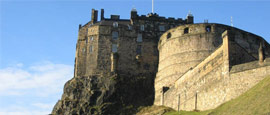Edinburgh History
It’s impossible not to feel the long arm of history as you walk along Edinburgh’s grand New Town boulevards and steep, narrow Old Town streets. The city wears its past proudly, from the towering volcanic crag of its castle to the modern day parliament that stands opposite the Palace of Holyroodhouse.
Human settlement in the Scottish capital dates back over 3,000 years, with evidence of dwellings found high on the castle hill. It wasn’t until the 11th century, though, that the city began to expand down from the castle along what is today known as the Royal Mile.
First given royal status by King David I in the 12th century, Edinburgh grew to play a key role in the Scottish Reformation of the 16th century, before King James VI became King James I of England in 1603. Despite the two countries now being royally linked, Edinburgh continued to suffer at English hands. Occupied by Cromwell’s forces in the wake of the English Civil War, it sheltered Jacobite rebels during the early 18th century, even though the two countries formed a political union in 1707.
Modern-day Edinburgh can be traced back to this period. Overcrowding and unsanitary conditions in what is now the Old Town led the city’s Lord Provost to announce a competition to design a new residential suburb, on virtually vacant land on the other side of what is now Princes Street Gardens. Its now UNESCO–protected streets were named after contemporary royals, designed to reaffirm Scottish commitment to the union.
It was at this time that Edinburgh’s status as an intellectual powerhouse was assured. At the centre of the 18th-century enlightenment, thinkers such as Adam Smith and David Hume helped make the city the ‘Athens of the North’.
Although the Old Town improved during the 19th century, Edinburgh faced a long period of decline in the 20th century due to the death of the industry and economic stagnation. Today’s city has been reinvigorated by Scottish devolution and the cultural currency of the Edinburgh festivals, created in the late 1940s and still held every August.
Did you know?
• Edinburgh's Old and New Towns have been UNESCO listed since 1995.
• Edinburgh became UNESCO's first ever 'city of literature' in 2004.
• The Edinburgh Fringe started after theatre groups who were not invited to the first International Festival showed up anyway and had to find performance spaces 'on the fringe'.
Do you have any Feedback about this page?
© 2025 Columbus Travel Media Ltd. All rights reserved. No part of this site may be reproduced without our written permission, click here for information on Columbus Content Solutions.




 You know where
You know where